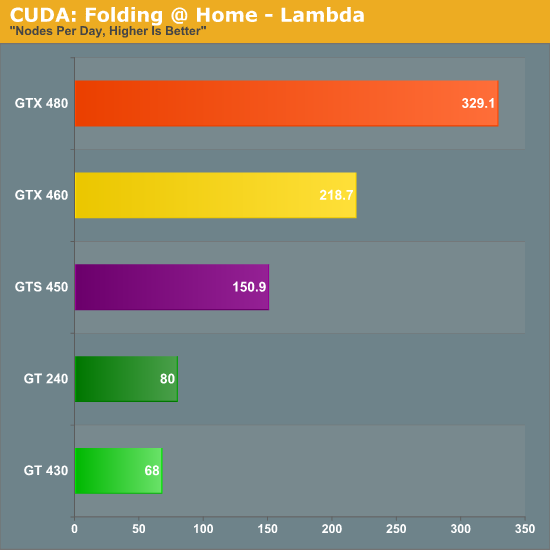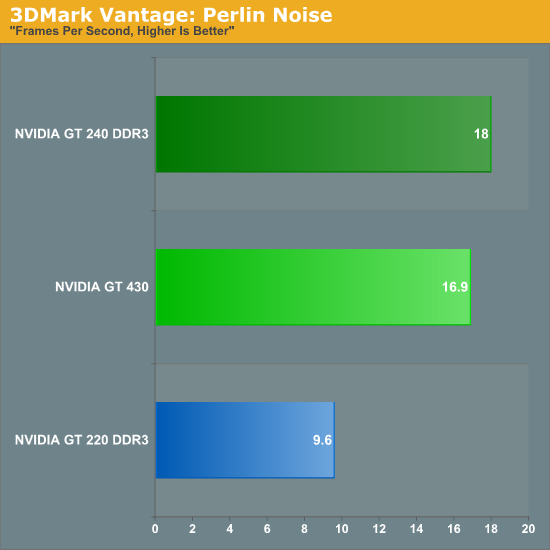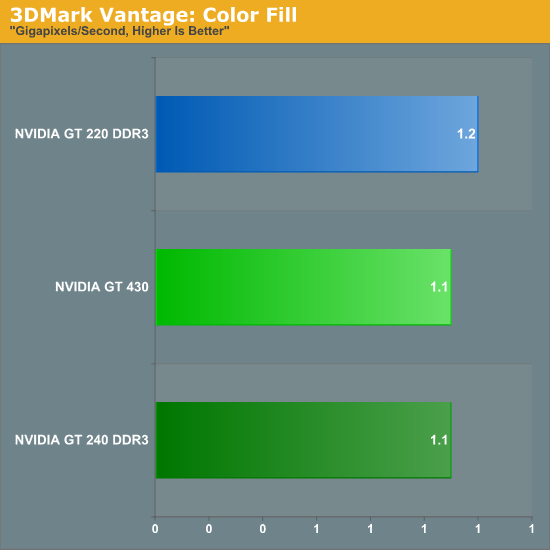NVIDIA's GeForce GT 430: The Next HTPC King?
by Ryan Smith & Ganesh T S on October 11, 2010 9:00 AM ESTCompute Performance & Synthetics
While the GT 430 isn’t meant to be a computing monster and you won’t see NVIDIA presenting it as such, it’s still a member of the Fermi family and possesses the family’s compute capabilities. This includes the Fermi cache structure, along with the 48 CUDA core SM that was introduced with GF104/GTX 460. This also means that it has a greater variation of performance than the past-generation NVIDIA cards; the need to extract ILP means the card performs between a 64 CUDA core card and a 96 CUDA core card depending on the application.
Meanwhile being based on the GF104 SM, the GT 430 is FP64 capable at 1/12th FP32 speeds (~20 GFLOPS FP64), a first for a card of this class.
For our look at compute performance we’ll turn to our trusty benchmark copy of Folding @ Home. We’ve also included the GT 240, a last-generation 96 CUDA core card just like the GT 430. This affords us an interesting opportunity to see the performance of Fermi compared to GT200 with the same number of CUDA cores in play, although GT 430 has a clockspeed advantage here that gives it a higher level of performance in theory.

The results are interesting, but also a bit distressing. GT 430’s performance as compared to the GTS 450’s performance is quite a bit lower, but this is expected. GT 240 however manages to pull ahead by nearly 17%, which is quite likely a manifestation of Fermi’s more variable performance. This makes the GT 220 comparison all the more appropriate, as if Fermi’s CUDA cores are weaker on average then GT 430 can’t hope to keep pace with GT 240.
To take a second look at CUDA core performance, we’ve also busted 3DMark Vantage out of the vault. As we’ve mentioned before we’re not huge fans of synthetic tests like 3DMark since they encourage non-useful driver optimizations for the benchmark instead of real games, but the purely synthetic tests do serve a useful purpose when trying to get to the bottom of certain performance situations.
We’ll start with the Perlin Noise test, which is supposed to be computationally bound, similar to Folding @ Home.

Once more we see the GT 430 come in behind the GT 240, even though the GT 430 has the theoretical advantage due to clockspeed. The loss isn’t nearly as great as it was under Folding @ Home, but this lends more credit to the theory that Fermi shaders are less efficient than GT21x CUDA cores. As a card for development GT 430 still has a number of advantages such as the aforementioned FP64 support and C++ support in CUDA, but if we were trying to use it as a workhorse card it looks like it wouldn’t be able to keep up with GT 240. Based on our gaming results earlier, this would seem to carry over to shader-bound games, too.
Moving on, we also used this opportunity to look at 3DMark Vantage’s color fill test, which is a ROP-bound test. With only 4 ROPs on the GT 430, this is the perfect synthetic test for seeing if having fewer ROPs really is an issue when we’re comparing GT 430 to older cards.

And the final verdict? A not very useful yes and no. GT 220 and GT 240 both have 8 ROPs, with GT 220 having the clockspeed advantage. This is why GT 220 ends up coming out ahead of GT 240 here by less than 100 MPixels/sec. But on the other hand, GT 430 has a clockspeed advantage of its own while possessing half the ROPs. The end result is that GT 430 is effectively tied with these previous-generation cards, which is actually quite a remarkable feat for having half the ROPs.
NVIDIA worked on making the Fermi ROPs more efficient and it has paid off by letting them use 4 ROPs to do what took 8 in the last generation. With this data in hand, NVIDIA’s position that 4 ROPs is enough is much more defensible, as they’re at least delivering last-generation ROP performance on a die not much larger than GT216 (GT 220). This doesn’t provide enough additional data to clarify whether the ROPs alone are the biggest culprit in the GT 430’s poor gaming performance, but it does mean that we can’t rule out less efficient shaders either.
Do note however that while Fermi ROPs are more efficient than GT21x ROPs, it’s only a saving grace when doing comparisons to past-generation architectures. GT 430 still only has ¼ the ROP power as GTS 450, which definitely hurts the card compared to its more expensive sibling.










120 Comments
View All Comments
cactusdog - Monday, October 11, 2010 - link
Thats weird, I've had heaps of ATI cards too and i've never had problems with any of them. How can you have problems with all of them, yet i dont have problems with any of them? weird.Belard - Monday, October 11, 2010 - link
I haven't had problems with my ATI cards...bupkus - Tuesday, October 12, 2010 - link
dittodnd728 - Tuesday, October 12, 2010 - link
Beats me.If it weren't for lucky people like you, I wouldn't have tried ATI yet again. I thought it was just a case of bad luck for me.
But now I'm seriously reluctant. They simply do not work for me.
If some ATI executive believes that it's unusual and wants to get to the bottom of it, then I'm here waiting.
gamara69 - Tuesday, October 12, 2010 - link
Work in IT and you will understand. Ever try to put a Radeon in the same system as a Fire GL? Can't, as they both use the same name for their .sys file and neither is compatable with both cards. BSOD on boot. Going back a bit, I had an environment with over 100 ATI Rage 128's. Because of slight differences in the models I required 18 different drivers. The wrong driver would cause BSOD's any time an app with a 3'D button opened. In my current environment we use no ATI video cards as we have driver issues in our multiple monitor setups. We have pulled all ATI cards and replaced them with Nvidia cards and our driver troubles have gone away.Not to say Nvidia is perfect, but at least I can get more than one of them to work regularly together.
AstroGuardian - Tuesday, October 12, 2010 - link
That's because you are new to computers. I have never had a single problem with both ATI and nVidia cards.RGN - Tuesday, October 12, 2010 - link
It wasn't that long ago that ATi drivers were renowned for being terrible and at the same time one of the many benefits of nVidia was the unified driver architecture. That being said, recently I've worked with the A MD/Ti Fire Pro series. Not for gaming, but hi end multi-display setups. The cards and drivers have been flawless - not at all what I expected. The Fire Pro's were selected because they were half height, passive cooling and quad display. There was not an equivalent nVidia card. Kudos to the AMD folk for winning this round!IceDread - Tuesday, October 12, 2010 - link
Weird.I've used Nvidia when I found them to have the better price / performance and AMD other times.
I've had more issues with Nvidia than with AMD (ATI).
I have seen a lot of people have issues with both companies cards.
I do however like that AMD releases drivers each month and makes an effort to improve. Nvidia seams to release drivers sporadically.
There is also one thing that annoys me very much with Nvidia. I can not purchase an nvidia graphic card to use for cuda and use a AMD graphic card as primary. Nvidia will then shut down this functionality. So in my view, nvidia is a bit more evil as a company.
dnd728 - Tuesday, October 12, 2010 - link
Ahh, good ol' days with ATI...Waiting every month for a driver update, uninstalling all drivers & software for my AIW one by one, reinstalling one by one, with reboots, checking out all new bugs, writing ATI's support, uninstalling, reinstalling, manually uninstalling everything, reinstalling, reinstalling all other PC drivers, uninstalling, reinstalling, trying suggested combinations of new and old drivers, uninstalling, reinstalling, and by the time they're out of suggestions - there's a new driver release!
I'm sooo over that.
But as stated YMMV.
IceDread - Tuesday, October 12, 2010 - link
Sometimes I wonder what people do with their computers to make them fail.Uninstall, rune drivesweeper, reboot, install, reboot. Same procedure for nvidia as ati...